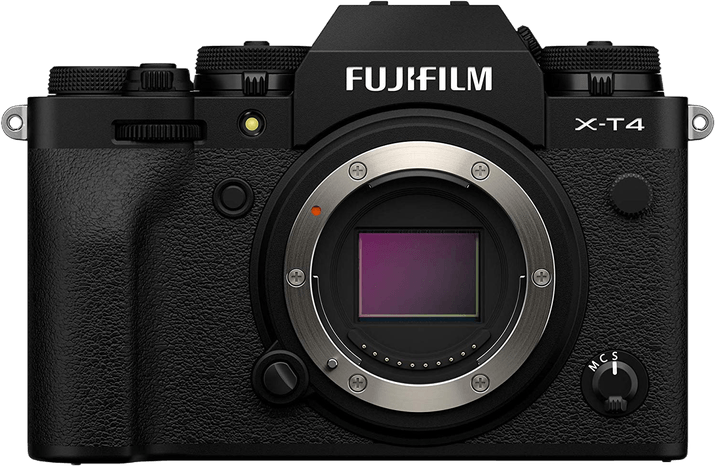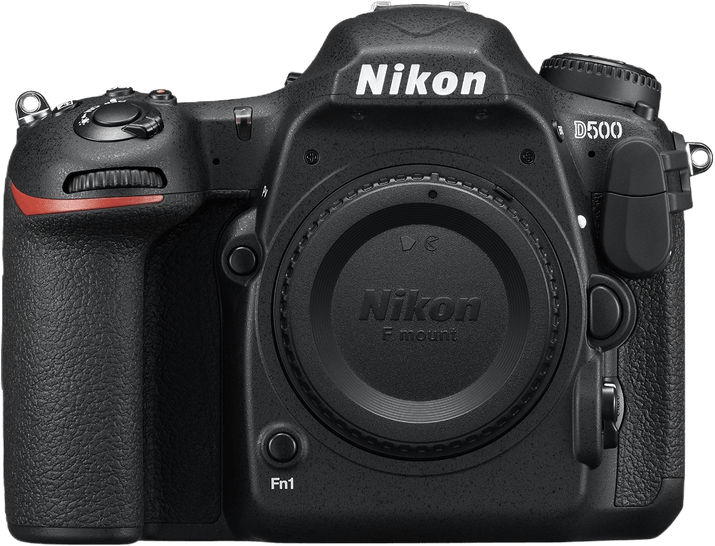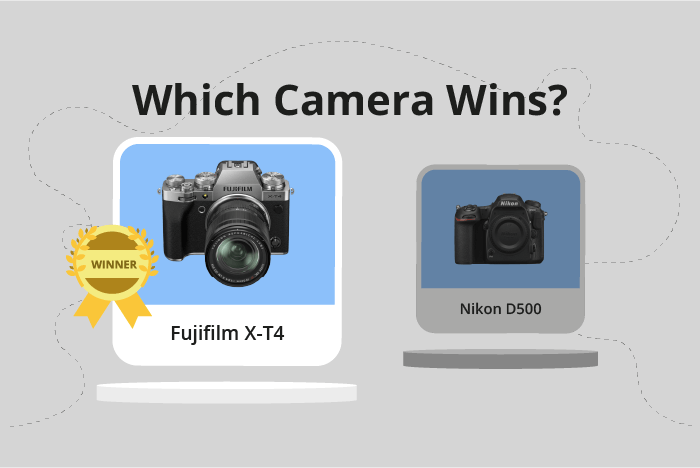Fujifilm X-T4 vs Nikon D500 Comparison
Fujifilm X-T4

Nikon D500

The Fujifilm X-T4 narrowly wins with a score of 76/100, while the Nikon D500 scores 75/100. Both cameras share some specifications: both announced in the 2010s (X-T4 in 2020 and D500 in 2016) and priced over $1000.
The Fujifilm X-T4, a mirrorless camera, excels in its compact size (135 x 93 x 84mm) and lightweight design (607g / 1.34lbs), making it more portable than the Nikon D500. The Nikon D500, a DSLR camera, has a larger size (147 x 115 x 81mm) and heavier weight (860g / 1.90lbs), which could be a disadvantage for some users.
However, the Nikon D500’s DSLR design might appeal to photographers who prefer the traditional DSLR experience. Despite the slight difference in scores, both cameras offer excellent performance and cater to different preferences. The Fujifilm X-T4 is ideal for those seeking a compact and lightweight option, while the Nikon D500 offers a more classic DSLR experience.
Fujifilm X-T4 vs Nikon D500 Overview and Optics
The Fujifilm X-T4 outperforms the Nikon D500 in optics with a score of 73 to 69. Both cameras share several specifications, including a CMOS sensor, an APS-C sensor size, and compatibility with their respective lens mounts, Fujifilm X for the X-T4 and Nikon F DX for the D500.
The X-T4 excels with its higher megapixel count of 26 compared to the D500’s 20.9, allowing for more detailed images. Additionally, the X-T4 boasts a shooting speed of 20 frames per second, double that of the D500’s 10. The X-Processor 4 in the X-T4 also contributes to its faster performance and better image quality. Furthermore, the X-T4 has built-in image stabilization, which the D500 lacks, making it more versatile for capturing sharp images in various conditions.
On the other hand, the D500 has a DXOMARK sensor score of 84, providing a benchmark for its sensor’s performance. However, it is important to note that DXOMARK does not score Fujifilm cameras, so a direct comparison is not possible. The D500 also uses the Expeed 5 processor, which ensures quality performance but falls short when compared to the X-T4’s X-Processor 4.
Taking these factors into account, the Fujifilm X-T4 emerges as the superior camera in terms of optics. Its higher megapixel count, faster shooting speed, and image stabilization provide users with better image quality and versatility. While the Nikon D500 has a respectable DXOMARK sensor score and a reliable processor, it cannot match the performance offered by the X-T4.
Fujifilm X-T4 vs Nikon D500 Video Performance
The Fujifilm X-T4 outperforms the Nikon D500 in video capabilities with a video score of 91/100, a 21-point difference compared to the D500’s score of 70/100. Both cameras share some common specifications, such as 4K video resolution and built-in time-lapse functionality. However, the X-T4 surpasses the D500 in several aspects, contributing to its higher score.
The X-T4 has a max video dimension of 4096 x 2160, while the D500’s max video dimension is 3840 x 2160. This difference allows the X-T4 to capture more detailed and sharper footage compared to the D500. Additionally, the X-T4 can achieve a max video frame rate of 120fps, significantly higher than the D500’s 30fps. This allows the X-T4 to capture smooth slow-motion footage, providing more versatility in video production.
The Nikon D500, despite having a lower score, still offers reliable video performance with 4K resolution and time-lapse functionality. Its 30fps max frame rate is suitable for most standard video recording needs. However, it falls short when compared to the X-T4’s superior video dimensions and frame rate.
The Fujifilm X-T4’s higher video score reflects its advanced video capabilities, making it a better choice for videographers and filmmakers seeking higher quality and more versatile performance. On the other hand, the Nikon D500 remains a solid option for those who require standard video features and do not need the additional benefits offered by the X-T4.
Fujifilm X-T4 vs Nikon D500 Features and Benefits
The Nikon D500 takes the lead in the features comparison with a score of 87/100, while the Fujifilm X-T4 follows closely at 85/100. Both cameras share several specifications, such as a touchscreen, flip screen, and the absence of GPS. They also both have WIFI and Bluetooth capabilities.
The Nikon D500 outperforms the Fujifilm X-T4 in terms of screen size and resolution. Its 3.2-inch screen is larger than the 3-inch screen of the X-T4. Additionally, the D500 boasts a higher screen resolution of 2,359,000 dots, compared to the 1,620,000 dots on the X-T4. This difference results in a clearer and more detailed display on the Nikon D500.
On the other hand, the Fujifilm X-T4 still offers competitive features. Despite having a slightly smaller screen and lower resolution, it remains a strong contender in the market. Its touchscreen and flip screen capabilities match those of the Nikon D500, and it shares the same connectivity options. Therefore, the X-T4 is not significantly inferior to the D500 in terms of features.
When comparing the Fujifilm X-T4 and Nikon D500, it is clear that the Nikon D500 has a slight advantage in the features department due to its larger screen and higher resolution. However, the Fujifilm X-T4 remains a viable option for those seeking a camera with comparable features. Ultimately, the choice between these two cameras depends on the individual’s preferences and priorities.
Fujifilm X-T4 vs Nikon D500 Storage and Battery
The Nikon D500 outperforms the Fujifilm X-T4 in storage and battery with a score of 79/100 compared to 73/100. Both cameras have two memory card slots and accept SD, SDHC, and SDXC (UHS-II compatible) cards. However, the D500 also accepts XQD cards, giving it an edge in storage options.
The D500’s battery life is significantly longer, providing 1240 shots per charge with its EN-EL15 battery, while the X-T4’s NP-W235 battery lasts for 500 shots. This makes the D500 a more reliable choice for extended shooting sessions.
The X-T4 does have one advantage: USB charging. This feature offers convenience and flexibility for on-the-go photographers who need to charge their camera quickly.
Considering the storage and battery aspects, the Nikon D500 is the better option due to its greater battery life and additional memory card compatibility. However, the Fujifilm X-T4’s USB charging capability may be a deciding factor for some users.
Alternatives to the Fujifilm X-T4 and Nikon D500
Are you still undecided about which camera is right for you? Have a look at these popular comparisons that feature the Fujifilm X-T4 or the Nikon D500:

